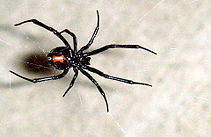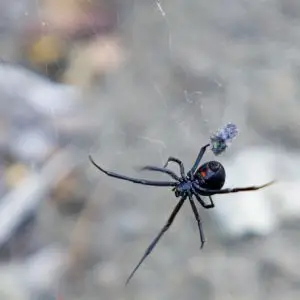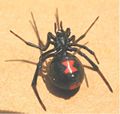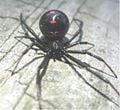Black widow spider
| Black widow | ||||||||||||
|---|---|---|---|---|---|---|---|---|---|---|---|---|
 | ||||||||||||
| Scientific classification | ||||||||||||
| ||||||||||||
|
L. mactans Fabricius, 1775 |
The black widow spider (Latrodectus spp.) is a spider notorious for its neurotoxic venom. It is a large widow spider found throughout the world and commonly associated with urban habitats or agricultural areas. Although the name 'black widow spider' is most commonly used to refer to the three North American species best known for their dark coloration, black hair and red hourglass pattern, occasionally it is applied to several other members of a the Latrodectus (widow spider) genus in which there are 31 recognized species including the Australian red-back, brown widow spider (sometimes called the gray widow), and the red widow spider. In South Africa, widow spiders are also known as the button spiders.
Currently, there are three recognized species of black widow found in North America: The southern black widow (L. mactans), the northern black widow (L. variolus), and the western black widow (L. hesperus). As the name indicates, the southern widow is primarily found (and is indigenous to) the southeastern United States, ranging from Florida to New York, and west to Texas, Oklahoma and they run particularly rampant in parts of Arizona.
The northern widow is found primarily in the northeastern U.S. and southeastern Canada (only on the Bruce Peninsula), though its ranges overlap that of L. mactans quite a bit. The western widow is found in the western half of the United States, as well as in southwestern Canada and much of Mexico. Prior to 1970, when the current taxonomic divisions for North American black widows were set forth by Kaston, all three varieties were classified as a single species, L. mactans. As a result, there exist numerous references which claim that "black widow" (without any geographic modifier) applies to L. mactans alone. As common usage of the term "black widow" makes no distinction between the three species (and many laypersons are unaware of the differences between them), and as the three species have much in common, this article treats all three species of black widow equally. Except where otherwise indicated, the remainder of the article applies to all three of the above species.
Description
Only young female black widow spiders are gloss black with an hourglass shaped marking on the underside of its abdomen which, although most commonly red, may range in color from white to yellow to various shades of orange and red. They also bear a small, usually red (colors vary) dot near the spinnerets, which is separate from the hourglass. In L. variolus, the two halves of the hourglass shape may be separated into two separate patches. A large female black widow spider can grow to about 1.5 inches (38 mm), counting legspan. The body is about 0.5-0.6 inches (12-16 mm). Male black widow spiders are half the size of the female or smaller. They have longer legs and a smaller abdomen in relation to their body size. They are also usually dark brown with varying colors of stripes/dots, with no hourglass mark. Adult males can be distinguished from juvenile females by their more-slender body, longer legs and large pedipalps typical of most other male spiders.
As with many venomous creatures, the brightly colored markings serve as a warning to predators. Eating a black widow will normally not kill a small predator (birds, et cetera), but the sickness that follows digestion is enough for the creature to remember that the bright red marking means "do not eat." Because the adult female black widow typically hangs and moves about its web upside down, its hourglass is on its front. Juvenile female widows spend a large quantity of time in search of an optimal environment. Once an optimal location is found, adult female widows often spend their entire lives in one place. Because juvenile females must first find this optimal location, they bear brightly colored marks upon their backs, so that they may be seen by predators when the widow is walking using its legs. Males bear similar marks to the females to serve as warning while they are searching for mates, however, the marks are not as prominent (not as brightly colored, or as large). Males, being less venomous, are less of a threat to predators, so having less prominent but similar marks helps predators to better judge their prey (some large birds can eat male widows without adverse effect, and so only avoid female spiders; those who cannot eat any widow without adverse effect eat nothing with the marks). Female juveniles develop an hourglass before the dorsal markings are shed. As is characteristic of all arthropods, black widow spiders have a hard exoskeleton composed of chitin and protein. [1]
Prey
Black widow spiders typically prey on a variety of insects, but occasionally they do feed upon woodlice, diplopods, chilopods and other arachnids.[2] When the prey is entangled by the web, L. mactans quickly comes out of its retreat, wraps the prey securely in its strong web, then punctures and envenomates its prey. The venom takes about ten minutes to take effect; in the mean time, the prey is held tightly by the spider. When movements of the prey cease, digestive enzymes are released into the wound. The black widow spider then carries its prey back to its retreat before feeding.[3]
Reproduction
When a male is mature, he spins a sperm web, deposits semen on it, and charges his palpi with the sperm. Black widow spiders reproduce sexually when the male inserts his palpus into the female's spermathecal openings. The female deposits her eggs in a globular silken container in which they remain camouflaged and guarded. A female black widow spider can produce four to nine egg sacs in one summer, each containing about 100-400 eggs. Usually, eggs incubate for twenty to thirty days. Rarely do more than one hundred survive through this process. On average, thirty will survive through the first molting, due to cannibalism, lack of food, or lack of proper shelter. It takes two to four months for black widow spiders to mature enough to breed, however full maturation typically takes six to nine months. The females can live for up to five years, while a male's lifespan is much shorter. Contrary to popular belief, the female only rarely eats the male after mating, and L. mactans is the only black widow species for which this form of sexual cannibalism has been observed in the wild. Lifespans depend upon environment, with shelter being the greatest determining factor and food the second greatest.[4]
Natural enemies
There are various parasites and predators of widow spiders in North America, though apparently none of these have ever been evaluated in terms of augmentation programs for improved biocontrol. Parasites of the egg sacs include the flightless scelionid wasp Baeus latrodecti, and members of the chloropid fly genus Pseudogaurax. Predators of the adult spiders include a few wasps, most notably the blue mud dauber, Chalybion californicum, and the spider wasp Tastiotenia festiva. Other species will occasionally and opportunistically take widows as prey, but the preceding all exhibit some significant specific preference for Latrodectus.
Venom
Although their venom is extremely potent, (15 times more potent than that of the rattlesnakes; it is also reported to be much more potent than the venom of cobras and coral snakes), these spiders are not especially large. Spiders bite but do not sting, though it can sometimes feel like being stung. Compared to many other species of spiders, their chelicerae are not very large or powerful. In the case of a mature female, the hollow, needle shaped part of each chelicera, the part that penetrates the skin, is approximately 1.0 mm (around .04 inch) long, sufficiently long to inject the venom to a dangerous depth. The males, being much smaller, can inject far less venom and inject it far less deeply. The actual amount injected, even by a mature female, is very small in physical volume. When this small amount of venom is diffused throughout the body of a healthy, mature human, it usually does not amount to a fatal dose (though it can produce the very unpleasant symptoms of latrodectism). Deaths in healthy adults from Latrodectus bites are relatively rare in terms of the number of bites per thousand people. Only 63 deaths were reported in the United States between 1950 and 1989. On the other hand, the geographical range of the widow spiders is very great. As a result, far more people are exposed, world-wide, to widow bites than are exposed to bites of more dangerous spiders, so the highest number of deaths world-wide are caused by members of their genus. Widow spiders have more potent venom than most spiders, and prior to the development of antivenom, 5% of reported bites resulted in fatalities. The venom can cause a swelling up to 15 cm.
Improvements in plumbing have greatly reduced the incidence of bites and fatalities in areas where outdoor privies have been replaced by flush toilets. In Sweden there have been incidents with black widow spiders being found in cars imported from southern U.S.[1] Old cars standing unused are an attractive habitat for the spider.
There are a number of active components in the venom:
- Latrotoxins
- A number of smaller polypeptides - toxins interacting with cation channels which display spatial structure homology - which can affect the functioning of calcium, sodium, or potassium channels.
- Adenosine
- Guanosine
- Inosine
- 2,4,6-trihydroxypurine.
The venom is neurotoxic. [2]
Pharmaceutical applications
Research in Chile about increased virility resulting from Black Widow spider bites found spermicidal qualities associated with the venom, in addition to rumored priapism coupled with involuntary ejaculation. "Spider bitten" men anecdotally had "super virility" after recuperating from a spider bite.
Researchers hope to be able to create a topical contraceptive and a marketable alternative to other virility treatments.
Photos
Notes
- ↑ TA Miller. "Latrodectism: bite of the black widow spider." American Family Physician. (1992)
- ↑ Latrodetus Mactans - Retrieved September 24, 2007.
- ↑ Foelix, Rainer F. Biology of spiders. {Cambridge, Mass: Harvard University Press, 1982, ISBN 0674074319), p.162-163
- ↑ Black Widow Spider Fact Sheet. - Retrieved September 24, 2007.
External links
- Latrodectus Mactans on Pterodattilo - Retrieved September 24, 2007.
- Virginia Cooperative Extension: widow spiders - Retrieved September 24, 2007.
- University of Washington Burke Museum spider myths - Retrieved September 24, 2007.
- Bites and stings of medically important venomous spiders - UCR - Retrieved September 24, 2007.
- Pictures of L. mactans - Retrieved September 24, 2007.
Credits
New World Encyclopedia writers and editors rewrote and completed the Wikipedia article in accordance with New World Encyclopedia standards. This article abides by terms of the Creative Commons CC-by-sa 3.0 License (CC-by-sa), which may be used and disseminated with proper attribution. Credit is due under the terms of this license that can reference both the New World Encyclopedia contributors and the selfless volunteer contributors of the Wikimedia Foundation. To cite this article click here for a list of acceptable citing formats.The history of earlier contributions by wikipedians is accessible to researchers here:
The history of this article since it was imported to New World Encyclopedia:
Note: Some restrictions may apply to use of individual images which are separately licensed.










